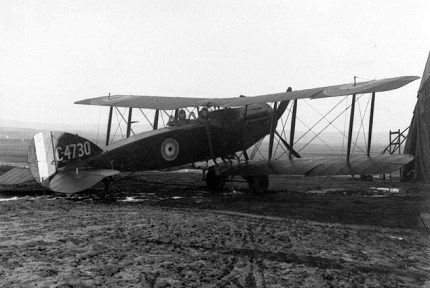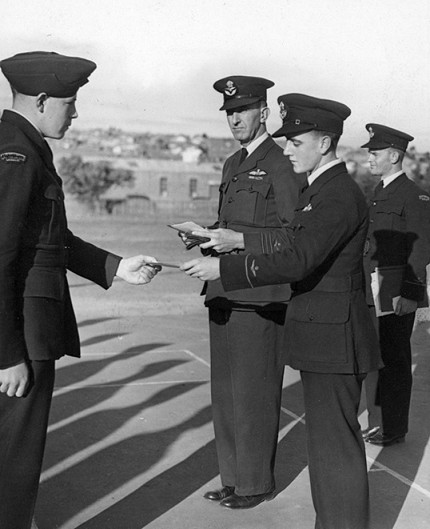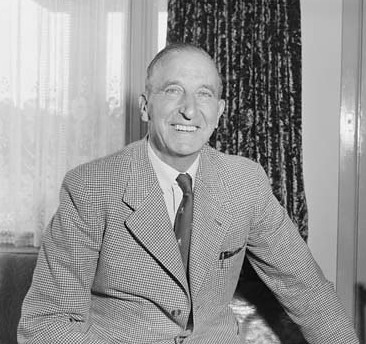Melbourne Tram Museum
- Follow Melbourne Tram Museum on Twitter
- Follow Melbourne Tram Museum on Facebook
- Follow Melbourne Tram Museum on Instagram
- Follow Melbourne Tram Museum on Pinterest
- Follow Melbourne Tram Museum on Tumblr
- Subscribe to Melbourne Tram Museum's RSS feed
- Email Melbourne Tram Museum
Tramway ANZAC: Francis Cooper Penny
Decorated WWI fighter pilot
Frank Penny was 23 and a conductor at Essendon Depot, working for the North Melbourne Electric Tramway & Lighting Company, when he enlisted in the Australian Imperial Force (AIF) on 10 March 1916. He was born in Ruffy, a small town 175km north of Melbourne and was the second son of a local farming family with eight children. The family farm was 520 acres in size. Ruffy had also been the home of Leslie Magyar, who was awarded a Victoria Cross in the Second Boer War.
Penny was posted to the 38th Infantry Battalion, a new unit being formed at Bendigo in March 1916. Most of the volunteers in the unit were from Northern Victoria, as was Penny by birth. Early training was at Epsom Racecourse, but an outbreak of serious illness saw the unit moved to Campbellfield, where pre-embarkation training was completed.
He embarked from Melbourne on 20 June 1916 on HMAT Runic A54. The convoy sailed to Plymouth, England via Cape Town, arriving on 10 August 1916. The battalion was assigned to the newly formed 3rd Australian Division under the command of Major-General John Monash, and was intensively trained over the following months on Salisbury Plain. A highlight of this period was a review of the division by King George V on 27 September 1916.
On completion of training, the 3rd Division was moved across the channel to France in November 1916. 38th Battalion was first committed to the front lines at Houplines on 1 December. Over the winter of 1916-17, the battalion conducted numerous raids across no-man’s land into the German trenches.
However, it appears that the dangers of winter-time trench warfare on the Western Front were not enough for Penny. He volunteered for service in the Royal Flying Corps (RFC) on 2 March 1917, and was posted to the School of Military Aeronautics at Oxford on an Observer’s course. He successfully passed the course, and was granted a temporary commission in the RFC as a probationary 2nd Lieutenant and Flying Officer (Observer) as from 4 April 1917. Penny was discharged from the AIF on the previous day.
The most important role of the RFC during the First World War was Artillery Observation – observing the fall of artillery shells, directing fire through wireless communication, and performing photo-reconnaissance of enemy territory. Two-man biplanes were used to perform this task, manned by a pilot and an observer. Observers were required to be skilled in operation of cameras, wireless telegraphy, and air gunnery using the Lewis machine gun – the last being critical in defending the slow observation aircraft against German fighters.
Penny was assigned to 12 Squadron direct from his Observer’s course, flying in BE.2 and RE.8 aircraft. However, transferring to aircrew in the RFC had moved him from the perils of the trenches to the most dangerous occupation in the war. In fact, April 1917 in France became known amongst RFC fliers as ‘bloody April’. At this time new aircrew had an average life expectancy of less than three weeks on operations, the worst casualty rate of the entire war – and this was the environment that Penny had just joined.
Anti-aircraft fire – known by RFC aircrew as ‘Flying Onions’ – and German fighter planes were a constant danger. A persistent fear of aircrew was being trapped in a burning aircraft.
RFC aircrew were not issued with parachutes. It was thought by British High Command that having parachutes would deter aircrew from engaging the enemy, by indulging in cowardly behaviour by jumping from the aircraft when threatened by German fighters. This attitude is completely against modern psychological studies, which have decisively proven that the availability of safety equipment such as parachutes encourages risk-taking (or courageous) behaviour. It is well-known by modern air forces that pilots will engage the enemy more willingly in aircraft fitted with ejection seats and parachutes, knowing that they have an even chance of getting out of a crippled aircraft before it crashes.
Subsequently many RFC pilots and air-gunners chose to jump from their burning aircraft, choosing a ‘clean’ quick death rather than the agony of being burnt to a crisp.
It was not until September 1918 that British High Command decided to equip their aircrew with parachutes. However, no parachutes were available for issue before the end of the war.
Unlike so many of his comrades, Penny survived his posting at 12 Squadron without a scratch. He was confirmed in his rank as 2nd Lieutenant on 12 August 1917. In early 1918 he underwent training as a pilot, and was passed as a Flying Officer on 24 February 1918. He was posted to 36 (Night Flying) Squadron in England, flying the Bristol F.2b Fighter, the premier two-seat fighter aircraft of the war.
 Australian Flying Corps Bristol F.2b Fighter in Palestine, 1918. The
F.2b was used by both the RFC and the AFC.
Australian Flying Corps Bristol F.2b Fighter in Palestine, 1918. The
F.2b was used by both the RFC and the AFC.- Photograph courtesy Australian War Memorial.
On 1 April 1918, the RFC was combined with the Royal Naval Aerial Service to form the Royal Air Force (RAF), the first independent air force in the world.
While serving with 36 Squadron, Penny fulfilled a range of different missions from Britain, including escort duties for shipping convoys. On one occasion, he observed a U-boat make a successful torpedo attack on a merchant ship. In response, he pressed home a low-level attack with the two bombs fitted to his aircraft and sank the U-boat.
36 Squadron was also assigned to air-defence duties, protecting Britain against attack by Zeppelin airship raids and Gotha bomber attacks. One night Penny was sent to search for a reported Zeppelin. After some time, he spotted the airship and climbed to meet it. However, when he reached 19,000 feet – the altitude ceiling for his Bristol Fighter – he could climb no higher to intercept. Despite this, he managed to fire upon the Zeppelin, forcing the airship to climb and turn away from land, back towards its base across the North Sea.
At these heights hypoxia was a constant danger, as First World War aircraft did not carry oxygen for aircrew. Pilots and air-gunners were in constant danger of passing out at such high altitudes. Loss of control and crashing the aircraft in these circumstances were not unusual. During the Second World War, British aircrew were required to wear oxygen masks at any height over 10,000 feet to avoid the effects of oxygen deprivation.
After the end of the war, Penny was posted to 141 Squadron stationed at Biggin Hill, now part of Greater London, still flying Bristol Fighters. His commanding officer was Major B.E. Baker, later Air Marshal Sir Brian Baker and AOC (Air Officer Commanding) of RAF Transport Command during the Berlin Airlift of 1948-49. In March 1919 the squadron was posted to the Tallaght aerodrome near Dublin, Ireland. This was during the Irish War of Independence, or Anglo-Irish War, of 1919-21. The main purpose for the presence of the squadron was to keep the peace in the area around Dublin.
The squadron undertook reconnaissance flights, seeking evidence of military training for Sinn Féin or IRA troops in the Wicklow mountains, and ‘showed the flag’ by demonstrating formation flying and aerobatics over Dublin. In June 1919 aviation pioneers Alcock and Brown crash-landed their Vickers Vimy aircraft in an Irish bog at the end of the first non-stop Transatlantic crossing. Penny was part of the RAF detachment that recovered and made running repairs to their plane, enabling the two intrepid aviators to fly on to London.
After years of inaction over Home Rule for Ireland, the presence of British forces was bitterly resented by the Irish. They were perceived as a hostile occupying army, and there were many murders of officers and men. It was unsafe for the airmen and women [1] of 141 Squadron to fraternise freely with the local population, so maintaining unit morale was a major problem.
A range of activities and diversions were organised, including joy flights for ground personnel, and sports competitions. Penny proved to be a successful high jumper and was selected to compete at a number of major events held by the RAF. He won the high jump event at the 1919 RAF track and field championships held at Uxbridge, and the Inter-Services Championships at Stamford Bridge in September 1919, where he was awarded a gold medal.
Penny was mentioned in despatches by the Air Ministry on 28 August 1919 in a large group notice “…in respect of the valuable services they[sic] have rendered in connection with the War, and a note to this effect will accordingly be made in the Official Records…”
Shortly after his sporting successes the Australian authorities requested that he report for repatriation to Australia, and he finally returned to Melbourne in January 1920. Penny relinquished his commission as a Lieutenant in the RAF on 31 January 1920. He received a rousing welcome home at his birthplace, where there was a celebration at Ruffy Hall on 5 March 1920.
In October 1922 Penny married Elizabeth Jessie ‘Beth’ Corrie at the Ascot Vale Methodist Church. They had one son, Ronald, who was later to serve in the Second World War, and became an academic at the University of Adelaide Psychology Department.
For many years, Penny was the aviation officer at Shell Oil, based in Melbourne. He was involved with several aviation pioneers and their record-breaking flights, including:
- the first powered glider in Australia, designed and built by S. Murray of Northcote (1931)
- Harry (Jim) Broadbent’s 1931 and 1935 record round-Australia flights.
During this period, the Penny family was living at 95 Pascoe Crescent, Ascot Vale – not far from Melbourne’s main airfield at Essendon Aerodrome.
During World War II Penny volunteered for service in the Royal Australian Air Force, rising to the rank of Squadron Leader. One of his postings was as the Officer-in-Charge of No 6 (Essendon) Air Training Corps. After the war, he continued to work for Shell as aviation manager, spending three months in 1947 on a study tour to the USA and the UK, examining the latest developments in aviation technology.
 Squadron Leader F.C. Penny (centre) at presentation of proficiency
certificates to RAAF Air Training Corps cadets, c1942.
Squadron Leader F.C. Penny (centre) at presentation of proficiency
certificates to RAAF Air Training Corps cadets, c1942.- Photograph Argus Newspaper Collection of Photographs, State Library of Victoria.
By the mid-1950s the Pennys had moved to Ringwood, then an outer suburb of Melbourne, and had become more involved in public work. Penny was appointed as a commissioner for taking declarations in 1956. He was also President of the Ringwood branch of the Good Neighbour Council, which was established in 1949 by the Federal Government to help migrants settle into local communities.
Penny’s wife Beth also was involved with local communities. She was the first female councillor for the city of Ringwood, serving two three-year terms from 1962, and was appointed mayor in 1966-67.
 Frank Penny, President of the Ringwood branch of the Good Neighbour
Council, 1958.
Frank Penny, President of the Ringwood branch of the Good Neighbour
Council, 1958.- Photograph courtesy National Archives of Australia.
In 1968 Penny was retired and living in the Adelaide suburb of St Georges. He passed away on 12 May 1973, survived by his wife, son and daughter-in-law, and two grandsons.
Bibliography
The Advertiser (1973), Deaths, 15 May 1973
The Argus (1931), First Power Glider in Australia, 25 August 1931
The Argus (1938), Deaths, 31 January 1938
The Argus (1938), Judicial and Law Notices, 27 April 1938
The Argus (1940), Deaths, 20 April 1940
The Argus (1947), City Personal, 12 April 1947
The Argus (1947), Silver Weddings, 18 October 1947
The Argus (1952), Today’s Engagements, 19 April 1952
Australian War Memorial (2015), Unit History – 38th Australian Infantry Battalion,
Euroa Advertiser (1920), Welcome Home at Ruffy, 12 March 1920
Euroa Gazette (1916), Exemption Court, 7 November 1916
Flight (1919), Mentioned in Despatches, 4 September 1919
Flight (1930), Brisbane-Melbourne in One Day, 28 March 1930
Flight (1949), Honour to the Air Lift, 15 December 1949
His Majesty’s Stationery Office (1917), Supplement to the London Gazette 30033, 24 April 1917, Wyman & Sons Limited
His Majesty’s Stationery Office (1917), Supplement to the London Gazette 30187, 17 July 1917, Wyman & Sons Limited
His Majesty’s Stationery Office (1917), Supplement to the London Gazette 30226, 11 August 1917, Wyman & Sons Limited
His Majesty’s Stationery Office (1918), Supplement to the London Gazette 30612, 5 April 1918, Wyman & Sons Limited
His Majesty’s Stationery Office (1920), London Gazette 31779, 13 February 1920, Wyman & Sons Limited
The Horsham Times (1929), Fiji’s First Aeroplane, 29 October 1929
National Archives of Australia (1914-18), Francis Cooper Penny – Service Record
Albert Palazzo (2002), Defenders of Australia – The Third Australian Division 1916-1991, Australian Military History Publications
Royal Air Force (1919), RAF Track and Field Championships 1919
William Sheehan (2005), British Voices from the Irish War of Independence 1918-1921, Collins Press, Cork.
Table Talk (1922), Marriages, 30 November 1922
Williamstown Chronicle (1933), St Andrew’s Men Society, 8 April 1933
Williamstown Chronicle (1949), Future Air Travel, 1 July 1949
Additional material
Penny’s private papers are held in the Imperial War Museum. A section of them concerning his service in the Anglo-Irish War of 1919-21 has been published as a chapter in British Voices by William Sheehan. Their catalogue entries may be found at:
- http://www.iwm.org.uk/collections/item/object/1030007095
- http://www.iwm.org.uk/collections/item/object/1030007096
Footnote
[1] Women’s Royal Air Force personnel were assigned to 141 Squadron.
